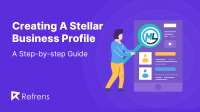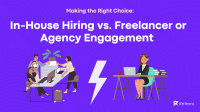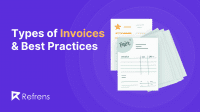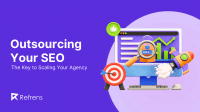If you’re a freelancer who has been working diligently for the last 1-2 years, chances are you have reached a growth saturation. You have a decent clientele that allows you to work 40+ hours per week at a decent price. With time, you did increase your rates, but now you’re at a point where you can’t justify increasing them further.
If that’s even slightly true, keep reading.
From here there are two paths – First, you carry on this phase with a slight moderation in your pricing and the quality of your clients; maybe potentially supplementing your income with passive revenue streams. Second, you move to an agency model.
A natural transition generally seen is to move from freelancing to running an agency. Although, there are a few questions you need to ask yourself first because not all freelancers can handle building an agency.
For those who want to explore the path, here are a few steps to help you transition smoothly.
8 Easy Steps To Go From Freelancer To Agency
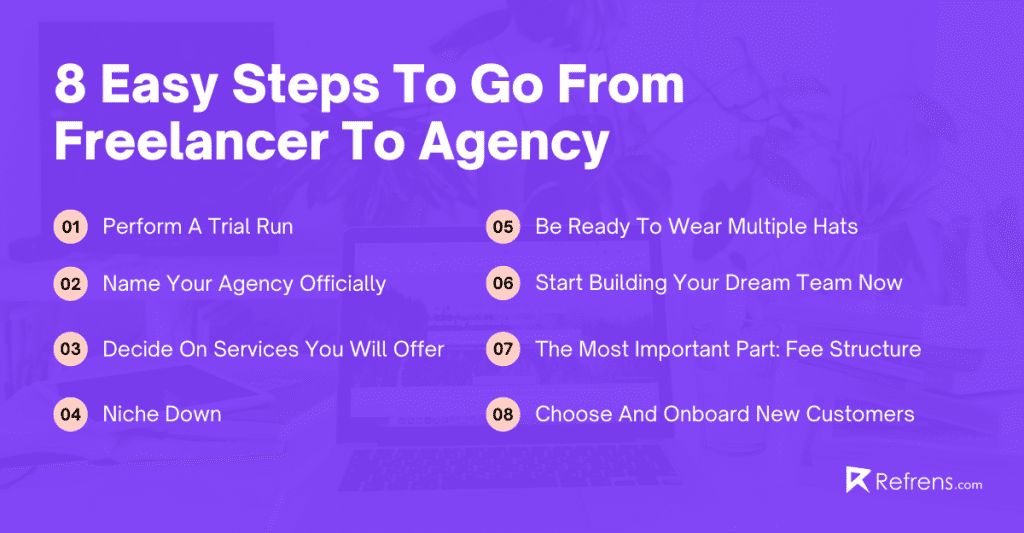
1. Perform A Trial Run
Delegating labor and overlooking the work is a difficult concept for many freelancers. Working on a couple of projects with a “team”, before diving head first into building an agency, is an excellent way to determine if it’s right for you.
Subcontracting some of your work to other newbie freelancers is a wonderful start. It’s a win-win because they get the lay of the land, and you get to see what it’s like to hand over a job to a coworker.
You might also consider hiring an assistant/intern to help you with some of your administrative or marketing tasks.
Once you learn how to allocate different duties and to deal with someone else’s approach to a brief, you can pivot your procedures as per the need.
Many agencies start off this way, with subcontractors working on a growing number of projects, while the owner fine-tunes the processes and skill set until it’s time to change the name on the door.
2. Name Your Agency Officially – LLP or Private Limited
Now that you have done some testing, it’s time to officially name your agency. This name is the foundation of all your future endeavors, so take some time and finalize this.
Trademarks, domain availability, and long-term suitability are all factors to consider. Rather than branding a person(you), you’re now branding a company.
When it comes to agency branding, it’s critical to have a clear understanding of the type of client you want to attract. And then comes the futuristic question, what do you want to achieve in the long run? Ensure that your name is not only fit for the company you’re starting today but also the company you’ll be expanding into. So you don’t outgrow it. And when bringing your agency into the legal field, both LLP and Private Limited work well for small businesses. You need to consider their characteristics and structures before setting up as limited company.
3. Decide On What Services You Will Offer
You must also establish what services you will provide before going all-in. You should consider the space, competitors, and industries you want to penetrate.
Begin by concentrating on your area of expertise, then expand your services as your team grows.
A freelance writer, for example, could create a content marketing business, while a designer could start a web design or branding firm. Transitioning into an agency that focuses on skills you’ve previously honed is an excellent way to get the formula right.
It is also completely okay to start a business that demands multiple skills – one of which is your skill. This will open up an avenue with your current clients who want to get more things done.
For example, assume you’ve worked as a content marketer and an SEO expert for a long time. Starting your own digital marketing agency makes sense because you already have experience in the sector, all you need is to add some skillsets like design and SEM to your agency.
It is not necessary to be an ecosystem, you could also provide only certain services to multiple clients.
If you choose this route, forming a referral arrangement with other related(but non-competitive) organizations is also beneficial.
4. Niche Down
Another crucial early-stage question is whether or not to focus on a specialty. You may work as a generic, 360-degree agency; giving services to firms of all sizes, in all industries. Or, you could focus on polishing a specific niche.
Choosing a niche has several benefits attached:
- It establishes immediate authority. It reduces the time to learn the nitty-gritty of one industry and then multiple ones. If you take on a new customer every time you have to learn about a new business or industry, you’ll spend a lot more time and money on training and education.
- Concentrating on just one will allow you to better understand the specialty and improve your ability to attract future clients.
- It acts as a distinguishing feature. If a prospect is examining ten agencies—nine generic agencies and one specialist agency—the one that specializes in their area will always be discussed.
Make sure there’s enough demand in that market for the services you offer and that demand will continue to rise over time so you may expand your business.
5. Be Ready To Wear Multiple Hats
You’ll have to master a lot of new skills as the founder/director of an agency. Your attention will have to shift from completing client briefs to planning and management in no time. The administration will frequently take precedence over creative efforts
Check out the 10 strategic roles of a freelancer.
You will probably not enjoy running an agency if you prefer to stay too much in the background.
A successful agency also requires excellent communication. Suppose you already have trouble with client communication and can’t seem to keep up with your email.
In that case, you’ll have difficulty keeping up with the expectations of agency communications. You’re not only dealing with a broader pool of clients, but you’re also leading a team that must interact with you and each other properly.
Remember, you’re running a business now. You are the owner. Nothing is out of scope.
Recommended Reads: E-invoicing In GST: A Complete Guide
6. Start Building Your Dream Team Now
Once the foundation is laid; clients are now walking in through word of mouth or referrals, the next step is determining which positions you acquire. This is dependent on your personal skills and shortcomings, as well as the services you intend to provide.
Questions to help here:
- What role will you not fit in, if scaled?
- What are the things you want to personally take care of?
- Do you want to personally scout new clients or hire a salesperson?
- What are the technical requirements that will need your attention?
- Is managing a team your cup of tea, or you would better have an executive take care of this?
Regardless of whatever positions you want to fill, you must first perform two critical tasks: select a leader and build an organizational chart. After choosing which positions need to be delegated, you will have a better understanding.
One other important question is – are you looking for full-time, part-time, or freelance employees? Each one comes with its own set of pros and cons.
- Full-time/part-time: Hiring full-time coworkers can provide support for a predetermined number of hours each week. The drawback is that you must pay a salary regardless of whether or not there is work to be done, and you will be responsible for other costs such as employment taxes and employer-sponsored benefits.
- Freelancing: The benefit of hiring freelancers is that you only pay for finished work, which is excellent if you’re just getting started and have limited cash. The downside is that freelancers may be able to find better-paying employment or be offered full-time work elsewhere, leaving you with little notice and client tasks that must be performed on time.
Once you’ve picked your structure and assembled your team, you’ll need to collaborate closely with them to ensure that you provide the most satisfactory service to your clients.
Recommended Reads: Top 7 Invoice Generator Software
7. The Most Important Part: Fee Structure
Agencies bill clients using three price structures: hourly, per-project, and retainer. As a freelancer, you were probably paid hourly or per project, but retainers are the preferred payment model for agencies.
Retainers are simply agency service subscriptions. The agency supplies the customer with services, several creative assets, hours of consultation, and other agreed-upon aspects in exchange for a monthly flat charge. Regardless of whether services are required, the client pays the cost in exchange for a portion of the agency’s time.
Check out the 16 effective ways to find high-paying clients.
Working on a retainer has several advantages:
- Over time, retainers increase revenue tremendously. If your monthly fee is $500, adding a new customer will raise your monthly payment by $500, allowing you to expand your agency with new client work.
- Retainers provide a more stable revenue stream. If you sell services on a project-by-project basis, your next round of revenue—and employee salaries—will be contingent on obtaining new projects. You may plan ahead with retainers. You’ll be able to tell when you need to hire additional personnel and when you can afford to do so.
- Retainers allow you to work with a broader range of clients. Concentrating all of your attention on a single client can be equivalent to putting too many eggs in one basket.
You may need to take mediocre work first to keep revenues coming in, but you should eventually transition to a retainer-only arrangement.
It’s critical to create various options for clients to choose from when creating a retainer price structure.
Check out how to price your customers as a freelancer in this article.
8. Choose And Onboard New Customers
Okay, the trial run is done. The foundation is established. The team is all set. You’re now ready to even choose your prospective clients.
Check out how freelancers should find clients in this blog.
There was a time you would say yes to every opportunity, but now it’s critical to thoroughly examine new clients and opportunities. It’s crucial to evaluate whether the working relationship is suitable for both parties before onboarding a new customer. Otherwise, you risk developing long-term partnerships that depress your morale and cause more harm than good.
The more time you spend ensuring that a client and a project align with your beliefs, culture, talents, and capacity, the more likely you are to succeed in launching and developing your firm.
It is undoubtedly a growth spurt to move from freelancing and establish a successful agency. But it’s not easy. That doesn’t mean it’s the only way. So before you pull the plug on your freelancing journey, make sure you know what would be required of you.
Read more: 15 Best Invoicing Software In 2024
Recommended Reads: Top Invoicing Software For Consultants




